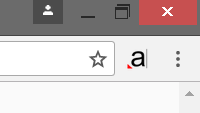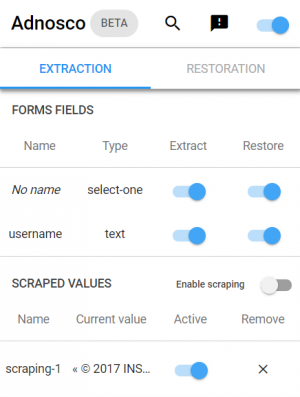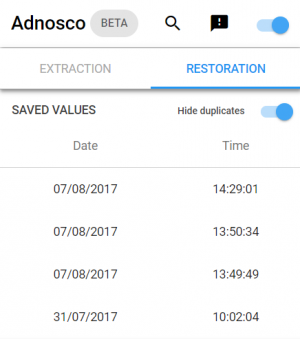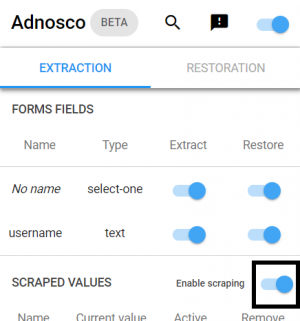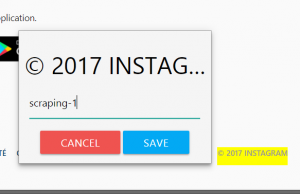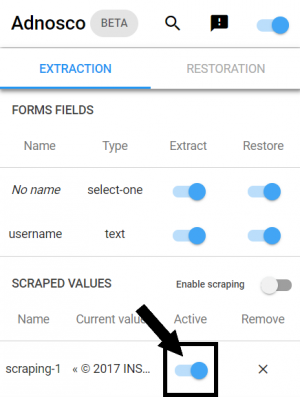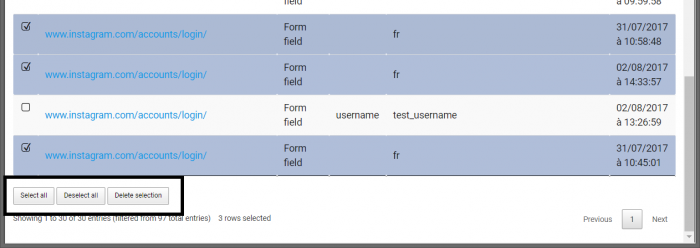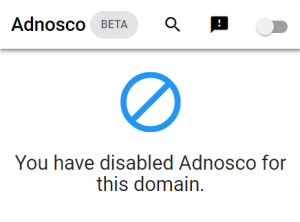Outils pour utilisateurs
Panneau latéral
Table des matières
User's manual
Forms extraction and restoration
Once it has been activated, Adnosco automatically saves the values you are sending through forms to the various websites you visit. It also allows you to restore these values.
Clicking on the Adnosco icon in the browser’s toolbar gives you access to a control panel where you can manage various settings. In the “Extraction” tab, you can enable or disable the extraction and/or the restoration of the form fields located on the webpage. In the “Restoration” tab, you can restore values saved on a previous visit.
Extraction
Let’s take an example: in the following screenshot of the popup’s Extraction tab, Adnosco shows that it has found 2 form fields on the webpage.
If you disable the extraction for the username form field, the various values that will be entered in that field will not be saved by Adnosco, starting now and until you enable the extraction for that field again.
This works similarly for the field’s restoration: if you disable it for the username form field, the restoration of values previously saved on the webpage will not restore any value for the username field until you enable the restoration for that field again (see the “Restoration” section).
Restoration
The Restoration tab of the control panel lets you preview and restore the values saved on a webpage on a previous visit.
The dates and times of your previous visits are listed. From there, you can:
- move your mouse cursor over one of the lines, which allows you to preview all the values the webpage you’re currently visiting had during the selected previous visit
- click on one of the lines, which will restore the form fields values that were saved during the selected previous visit
If you activate the hide duplicates toggle, the visits that have the same values as another visit will be hidden. Among all the duplicates, only the line corresponding to the earliest visit will be shown.
Value scraping
Adnosco lets you define a scraping on a part of a webpage. Once a scraping has been defined, it will save the value that is being displayed at its position every time you visit the webpage. Later, you can use the values preview function of the control panel’s “Restauration” tab to show the values that have been saved at each visit of the webpage.
Defining a scraping
To set a new scraping up, enable Adnosco’s scraping mode by activating the dedicated toggle in the “Extraction” tab of the control panel.
Then, select the text of the webpage you want to define a scraping for. Once you’re done selecting the text, a popup will show and ask you to enter a name for the scraping you are defining.
After entering a name, click “OK” to save the new scraping. It will now appear in the list of defined scrapings, at the bottom of the “Extraction” tab of the control panel.
Note: for simplicity reasons, Adnosco will define a scraping on the full text node that contains your selection. If you think the scraping suggested by Adnosco (marked with a yellow background) is too wide, try to divide your scraping into several smaller scrapings, located on the several nodes of the zone you want to define a scraping on.
Deactivate a scraping
You can deactivate a scraping if you do not wish for certain values to be scraped anymore. This will keep the previously scraped values stored, but will not store any new one for as long as the scraping is deactivated.
Delete a scraping
You can delete a scraping if you do not wish for certain values to be scraped anymore and have no intention to activate this scraping again in the future. Beware: this action will permanently delete all the values that have previously been scraped for this scraping.
Browsing interface
A browsing interface is available to use to navigate through the data Adnosco has saved. You can access it by clicking the magnifying glass icon in the extension’s control panel.
On the browsing interface page, you will be presented with a search form. Should you not change the default search parameters, every form field and scraping value will be displayed in the table at the bottom of the page. However, the form allows you to filter the results you would like to obtain.
The search parameters you can use are:
- Search by domain: allows to search the values saved on the specified domain
- Search by term: allows to search the values by comparing the specified term with the name of a field, its value, and in the case no domain has been specified in the previous search parameters, the domain name on which the field is located
- Search among (form fields and/or scrapings): checkboxes allowing to either restrict the search to form fields or scrapings, or to search through both categories.
- Search by dates: allows to restrict the search to a specific period in time. If only the field “from date” is filled, only values that have been saved after the specified date will be included in the search, and if only the “to date” field has been filled, only values that have been saved before the specified date will be included in the search.
The result table lists the values matching your search criteria. You can delete the values of your choice by selecting them and clicking the “delete” button located under the table. Two additional buttons allow to select/deselect all the values are also located under the table.

